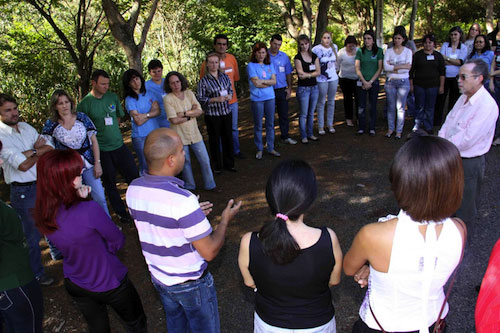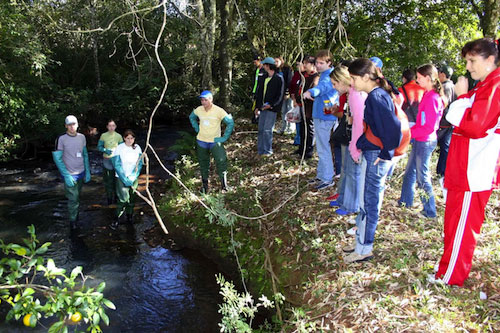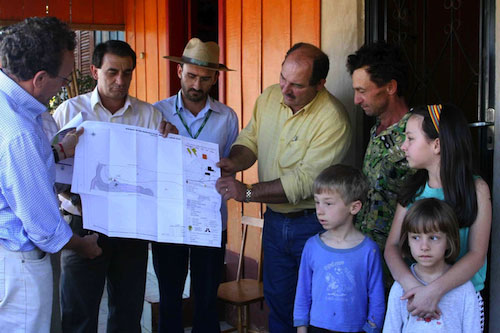Interview with Moema Viezzer
Sociologist and Brazilian writer, author of a classic Latin American book “Si me permiten hablar”, founder and president of Rede Mulher de Educacao.
Expert in Socio-environmental education, articulator of Environmental Education Agreement for Sustainable Societies and World Responsibility. Consultant of environmental education network in Cultivando Agua boa program.
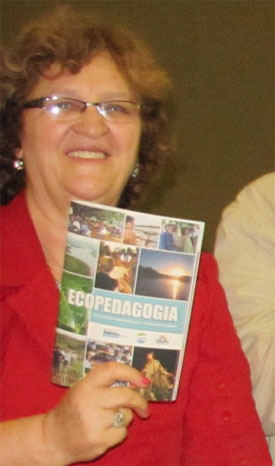
HIGH SOCIAL TECHNOLOGY
BAD “EDUCATION”
“Education” is a worn out and misunderstanding word. When I talk to people responsible for education management, including the international bodies, I always have the impression they confuse the education (environmental) with training. They do not visualize permanent transformer learning, based in concept and values, but it is considered as a technical issue.
If we want a transaction for a new paradigm, the education also needs to take this transaction. It is not a matter of changing terminology but change thinking.
Our teacher Paulo Freire had already talked so much about it when he told this concept of “banking education” is not good. It is not only about ‘teaching’ who ‘does not know’ it. Everybody has something to learn and at the same time something to teach.
THREE DIMENSIONS
You can see the Environmental Education as something separated or external: it needs to be in the center of the programs destined to the institutions, schools or for general population. For institutions, Environmental Education helps employers to understand where these changes entail, in addition to introduce new practices. In each institution, there are some people for and others against for this new perspective, it is hard to change without conflicts. To do something different, we work with values. People need to appropriate from these new ideas of sustainability, which shall be followed by a serial of well-concreted actions.
In fact, Environmental Education in the schools needs to start with adults and not only with professors, but also with direction and parents.
In a program of alimentary education for kids, we show the meaning of produce food for real world. In addition, who needs to participate? Professors? Yes, but also nutritionist, cooks and even the organic food farmers of our town. It is learning from where I live, from the space where I am acting, searching and understanding connections. Then, everything changes, including the vision of how the production, consumption, the commercialization shall be.
When we starting the organic school garden program, we create a bridge between education secretariat and agriculture secretariat whose technician helps in teaching. Working in a transverse way, we break this monolithic thing of each secretariat, each person does only its functions, without knowing what’s happening with others. The educators became interconnection agents among other secretariats of government.
Environmental Education directed to the general population has to battle with the fact which bodies from government are noticed as philanthropic structures, not a government itself. Several families live in extreme situations and it cannot leave the policy welfares so easily. However, it is necessary to prepare this reformulation work of needs, a re-education from concrete actions.
It is not about an isolated work in a group of educators. It is missed a political will which permeates into public institutions and permeate into population which, sometimes, they do not believe anything. Work with several communities that lost their faith from coming out of poverty. First, you need to invest for recovering faith from people and they shall realize they do not need to always live with alms.
LEARNING CIRCLES
In the Cultivando Agua Buena program, Environmental Education (EA) permeates the majority of subprograms: EA for recycling, Ea for organic agriculture, EA for medicinal plants, EA for management of drainage basins and so on. As Eastern people say, everything is in everything. If it covers an environmental problem as “generator matter”, in fact, it will take us into other problems.
Once, I was working about residue matters that take us about water matters. One person complained: “but here we do not talk about water, but residues” – “and where do we throw residues?” Environmental education that starts from transverse generator obligates people to open their mind, open their heart, and open themselves for learning.
At the same time, environmental matter necessarily takes to social matter. From a small action as recovery a spring, people notices the complexity of the processes, then, a conversation with social actors which intervene in the microbasin is necessary. Then, all actors responsible for this water in the territory are met to keep it protected and refined. The same process for organic agriculture, residues and other generator matters.
The idea is always work together, from a systemic vision. We need to realize that all actors who intervene in this space need to be part of this learning circle to see together which path they must take. As we can learn as we are solving community problems, each person brings his/her own experience and knowledge to grow as a community.
This way of work also entails the matter of solidarity. Neither talking about philanthropic sense, nor social works and others, but the solidarity as a feeling which results from awareness of interconnection among everybody, of local and planetary citizenship. Size, dimension or the cost do not matter, the most important is the will of acting. Nothing is small or merely operational. In the beginning of Cultivando Agua Buena program, some people told: “and about recovering this spring. What is it going to change?”, but, in the course of time, each town council will recover their spring, the stream will turn water back, people will use less agrotoxic and will not throw packing in the water. We are recovering our habitat. It creates a full new awareness trend and new activities.
PUBLIC POLICY
Not all this process can be obtained only by educators without being synchronized with public policies. The work of Environmental Education shall be situated in a more expanded perspective, it requires a political decision. Any institution, which covers Environmental Education, needs a strategy to build an alliance network, because many things depend on federal or state bodies. Therefore, we start devising our network with others who are in this transforming line.
In addition, from this basic network we connect with other people, groups and institutions which have abilities to assimilate and take root in this new work way.
I will be civil servant, teacher, community leader, I am going to take this concepts and values for my influence zone: to my office, to my school, to my church, to my labor union, to my family…
In this sense, Environmental Education needs to become in a public policy and transcend the administrative management. Educators need to know how to deal with intendants, secretaries, directors from institutions they are working, be in the management committee of town council… I am so tired of taking to only educators. We need to talk to legislators, public agents, businessmen, farmers, everyone who can interfere in environment needs to take this process.
MONOCULTURE OF MINDS
Cultivando Agua Buena program is developed in a strong monoculture region: soy-maize. That is why the conversation with farmers in the region was very important. They could not be rejected or be crucified by doing several wrong things. Their unsustainable practice has their root in previous politics of the State and the economical encouragement which make dismount easier. All these reflections make part of Environmental Education process.
As Vandana Shiva told in his speech: “When you see seeds, the way you look into it reflects your mind model. If I am for transgenic, agrotoxins, agroexport model, these reflect world development model which is pervade on me. In this famous book “Monocultura de las mentes”, she describes the architecture of this monoculture of thinking which led to framework of socio-environmental problems we live now. Here in our district, for example, a study about the use and abuse of agrotoxin related to strawberry. It was incredible, but owners did not eat the strawberry they plant because they were full of poison. They produced only for sale and the strawberry for own consumption were bought from organic farmers.
If they do not dismantle this mental model due profit, they do not care about happens with other people. The problem is not ignorance, but an impregnated model. However, these people could not release from it.
Everybody is trainee. Everybody needs to search new knowledge for becoming citizens qualified for acting in a local and global range. We work with people to release them from this model and introduce new ideas in their day-to-day. However, it is also important to know there are several other people-groups-institutions in other place in the world thinking and wishing the same thing.
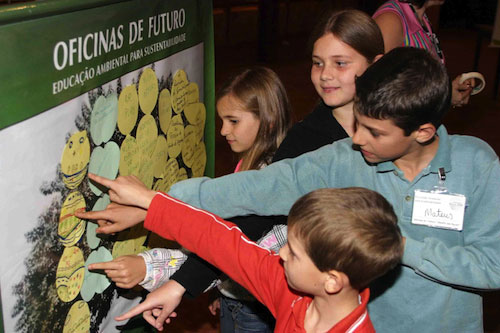
HIGH SOCIAL TECHNOLOGY
I found many people who know very much about environment, who are tired of speaking about the same today environmental matters and they considered it as an incredible loss of time, when I asked them to devote sometime of their speech for integration of participants. They hurried me: “and when are we going to start working?” In addition, why separate? If you want to create a new way of being, the most important is to be able to generate the synergy of interest due what we want to transform, recover or protect.
In the content from dialogic Environmental Education, we tried to recover something about all Western societies have been losing: the conversation, the art of exchange and share with. Usually, we only talk-talk-talk or only listen.
Bigger and bigger institutions are not bearing anymore this hierarchical and predatory way about human relationship.
This search for a more dialogic relation among human being and the human being with nature is made by a high technology.
Many times, the politicians asked us which economic value of Environmental Education is.
Sometimes, this economic value is not perceiving unless you prepare a work with new indicators, which show how many tons of garbage there are in the city or how much poison was used by farmers.
It is necessary to do it to show that any EA politics is not only so profitable to medium- to long-term, but also for a short-term where many lives are saved, the habitat is healthier and safer. The Environmental Education is an education for peace. Not peace about “lack of war”, but the peace with yourself, peace at home, less violence on the streets, in the schools. Environmental Education creates different, sustainable environments, where human being can walk, again, freely, drink clean water, eat food without poison, be in a house without barbed wire everywhere.

